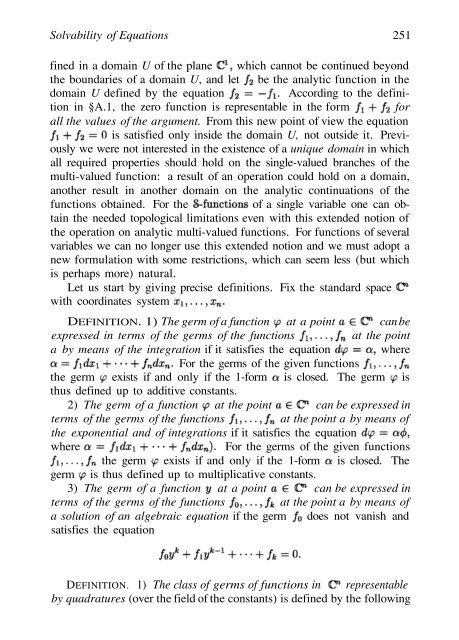Abel's theorem in problems and solutions - School of Mathematics
Abel's theorem in problems and solutions - School of Mathematics
Abel's theorem in problems and solutions - School of Mathematics
Create successful ePaper yourself
Turn your PDF publications into a flip-book with our unique Google optimized e-Paper software.
Solvability <strong>of</strong> Equations 251<br />
f<strong>in</strong>ed <strong>in</strong> a doma<strong>in</strong> U <strong>of</strong> the plane which cannot be cont<strong>in</strong>ued beyond<br />
the boundaries <strong>of</strong> a doma<strong>in</strong> U, <strong>and</strong> let be the analytic function <strong>in</strong> the<br />
doma<strong>in</strong> U def<strong>in</strong>ed by the equation Accord<strong>in</strong>g to the def<strong>in</strong>ition<br />
<strong>in</strong> §A.1, the zero function is representable <strong>in</strong> the form for<br />
all the values <strong>of</strong> the argument. From this new po<strong>in</strong>t <strong>of</strong> view the equation<br />
is satisfied only <strong>in</strong>side the doma<strong>in</strong> U, not outside it. Previously<br />
we were not <strong>in</strong>terested <strong>in</strong> the existence <strong>of</strong> a unique doma<strong>in</strong> <strong>in</strong> which<br />
all required properties should hold on the s<strong>in</strong>gle-valued branches <strong>of</strong> the<br />
multi-valued function: a result <strong>of</strong> an operation could hold on a doma<strong>in</strong>,<br />
another result <strong>in</strong> another doma<strong>in</strong> on the analytic cont<strong>in</strong>uations <strong>of</strong> the<br />
functions obta<strong>in</strong>ed. For the <strong>of</strong> a s<strong>in</strong>gle variable one can obta<strong>in</strong><br />
the needed topological limitations even with this extended notion <strong>of</strong><br />
the operation on analytic multi-valued functions. For functions <strong>of</strong> several<br />
variables we can no longer use this extended notion <strong>and</strong> we must adopt a<br />
new formulation with some restrictions, which can seem less (but which<br />
is perhaps more) natural.<br />
Let us start by giv<strong>in</strong>g precise def<strong>in</strong>itions. Fix the st<strong>and</strong>ard space<br />
with coord<strong>in</strong>ates system<br />
DEFINITION. 1) The germ <strong>of</strong> a function at a po<strong>in</strong>t can be<br />
expressed <strong>in</strong> terms <strong>of</strong> the germs <strong>of</strong> the functions at the po<strong>in</strong>t<br />
a by means <strong>of</strong> the <strong>in</strong>tegration if it satisfies the equation where<br />
For the germs <strong>of</strong> the given functions<br />
the germ exists if <strong>and</strong> only if the 1-form is closed. The germ is<br />
thus def<strong>in</strong>ed up to additive constants.<br />
2) The germ <strong>of</strong> a function at the po<strong>in</strong>t can be expressed <strong>in</strong><br />
terms <strong>of</strong> the germs <strong>of</strong> the functions at the po<strong>in</strong>t a by means <strong>of</strong><br />
the exponential <strong>and</strong> <strong>of</strong> <strong>in</strong>tegrations if it satisfies the equation<br />
where For the germs <strong>of</strong> the given functions<br />
the germ exists if <strong>and</strong> only if the 1-form is closed. The<br />
germ is thus def<strong>in</strong>ed up to multiplicative constants.<br />
3) The germ <strong>of</strong> a function at a po<strong>in</strong>t can be expressed <strong>in</strong><br />
terms <strong>of</strong> the germs <strong>of</strong> the functions at the po<strong>in</strong>t a by means <strong>of</strong><br />
a solution <strong>of</strong> an algebraic equation if the germ does not vanish <strong>and</strong><br />
satisfies the equation<br />
DEFINITION. 1) The class <strong>of</strong> germs <strong>of</strong> functions <strong>in</strong> representable<br />
by quadratures (over the field <strong>of</strong> the constants) is def<strong>in</strong>ed by the follow<strong>in</strong>g

















